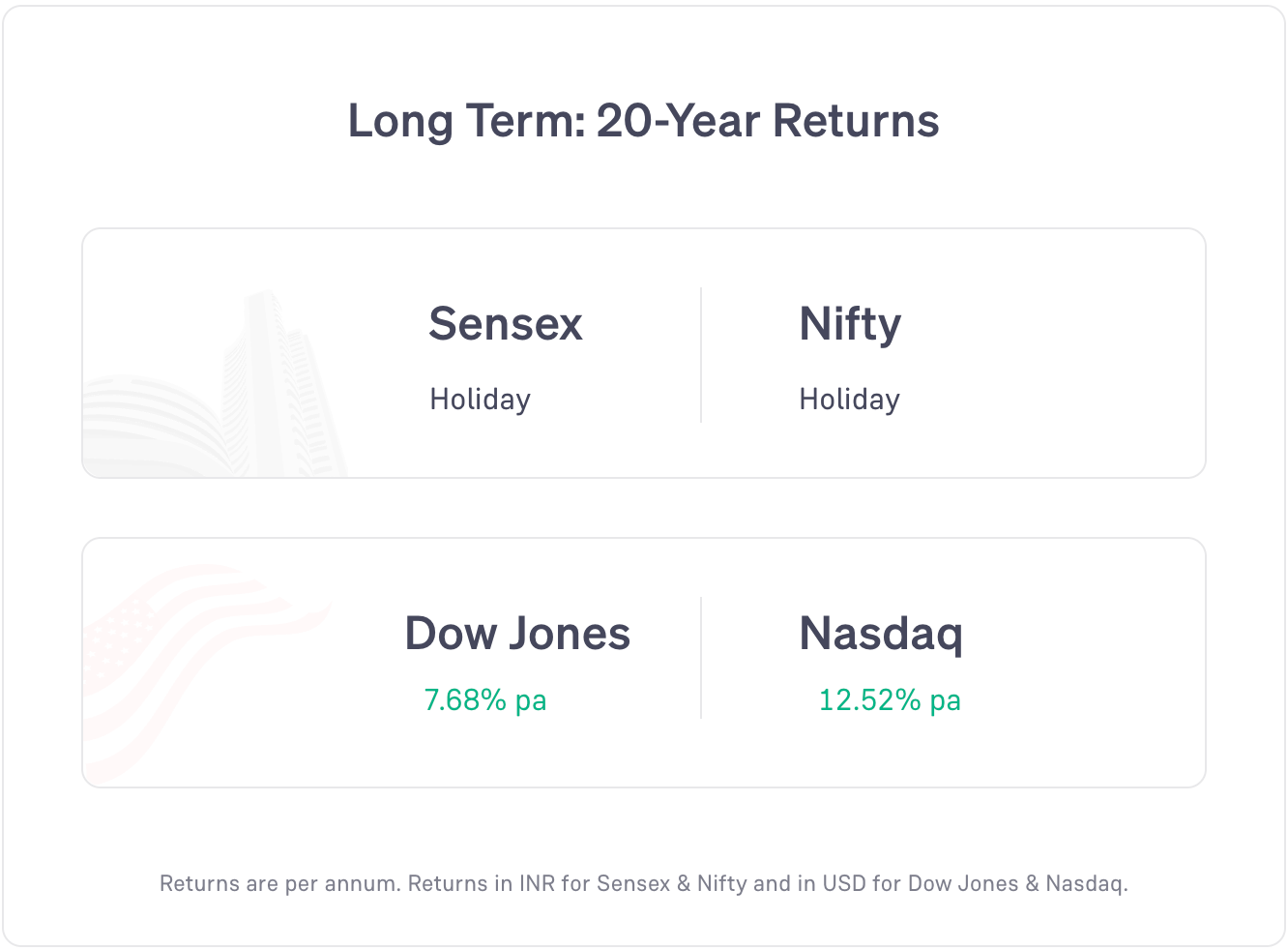Waaree Energies approves Rs 8,175 cr capex, markets closed today, & more -Groww Digest
Thursday, 2 October 2025
The Indian stock markets were closed today on account of Mahatma Gandhi Jayanti and Dussehra.
Hence, there won’t be any updates on the Nifty 50, Sensex, Top Gainers, and Top Losers sections today.
Global markets: US markets and Asian markets rose. European markets rose (as of 6 pm IST).
News
SEBI has introduced Validated UPI Handles and a SEBI Check tool for investors to authenticate UPI IDs and bank details of intermediaries to reduce fraud risk.
The Euro Area’s unemployment rate rose to 6.3% in Aug (vs 6.2% in July).
Stocks Updates
Waaree Energies: approved Rs 8,175 crore investment to increase lithium battery, electrolyser, and inverter manufacturing capacities through its subsidiaries.
Tata Power: company subsidiary, Tata Power Renewable, signed a Rs 1,200 crore power purchase agreement with Tata Power Mumbai to set up an 80 MW renewable project in 24 months.
Nestle: added a new Maggi noodles line at its Sanand, Maharashtra factory, of 20,600 tons per annum capacity with an investment of Rs 85 crore.
Adani Green: commissioned a solar power project of 50 MW and a wind power project of 31.2 MW at Khavda, Gujarat.
United Spirits: the Bombay High Court quashed Rs 443 crore water charge demand on the company, ordering reassessment. It directed the company to pay an interim deposit Rs 66.5 crore.
Wipro: dissolved its stepdown subsidiary, Aasonn Philippines Inc., as part of group restructuring.
Hyundai Motor: started passenger vehicle production at its new Talegaon, Pune plant with 1.7 lakh units annual capacity.
LTIMindtree: board fixed 24 Oct as the record date for a possible interim dividend to be decided in a board meeting on 16 Oct.
Auto Updates (Sept)
Maruti Suzuki: sales stood at 1.89 lakh units. Domestic sales stood at 1.35 lakh units and exports stood at 42,204 units.
M&M: sales grew 16% year-on-year to 1 lakh units. Passenger vehicle sales grew 10% year-on-year to 56,233 units.
Tata Motors: Commercial vehicle sales grew 19% year-on-year to 35,862 units. Passenger vehicles sales grew 47% year-on-year to 60,907 units.
Hyundai Motor: sales grew 10% year-on-year to 70,347 units including export sales of 18,800 units.
Eicher Motors: sales grew 43% year-on-year to 1.24 lakh units. Exports grew 41%.
TVS Motor: sales grew 12% year-on-year to 5.41 lakh units. Three-wheeler sales grew 60%.
Ashok Leyland: sales grew 9% year-on-year to 18,813 units.
Escorts Kubota: sales grew 47.6% year-on-year to 18,267 units. Exports grew 17.5%.
Bajaj Auto: total sales grew 9% year-on-year to 5.10 lakh units.
Word of the Day
Dearness Allowance (DA)
It is the money given to government employees and pensioners beyond their salary to keep up with the cost of living
It is paid as a percentage of the basic salary or pension, and it changes from time-to-time based on the cost of living.
Example: when the prices of food, fuel, and daily essentials go up, the government increases DA so that employees can maintain their purchasing power.
DA is a way to protect government employees’ income from the impact of inflation.
Example: Recently, on 1 Oct 2025, the Indian government increased the DA by 3%.
6 Day Course
Theme: thematic funds
Day 4: Thursday
Many investors make common mistakes when investing in mutual funds.
But one mistake is more relevant in case of thematic/sector funds.
Whenever a sector performs well, companies in that sector see their stock prices rise.
At this point, thematic and sectoral mutual funds also show incredibly high returns.
Many mutual funds start launching new NFOs targeting the same sector/theme.
Often, investors who start investing at this point, after the massive rise has occurred, end up seeing lower returns.
This is because they are entering the sector after the boom has already occurred and might not occur again for a long time.
In some cases though, the sector may continue to perform very well going forward.
This is why investors need to understand the sector/theme well before investing in these funds.
Featured Question
“Calculating capital gains for tax harvesting in Mutual funds (via SIP) gets complicated. Do we have to calculate change in NAV from buy price to current price for each SIP separately and add them or can we just calculate for the first and last one (assuming all the 12 SIP’s are more than 1 year older to get LTCG benefit)?”
Whenever you calculate tax in case of mutual funds, you need to consider:
-NAV at which you bought
-NAV at which you will sell
The difference in the values is the gains or profit.
(NAV is basically the price per unit of a mutual fund)
But, you need to do this for all units of a mutual fund you have.
Any time you invest some money in a mutual fund, you will get units.
Which means, the starting NAV will be different in case of every month’s SIP.
So, you will have to consider each month’s investment separately and calculate the gains accordingly.
This calculation can become complicated.
An easier way to do this is to simply look at the gains your mutual funds have made, and withdraw.
Just make sure you keep the gains under Rs 1.25 lakh while withdrawing every financial year. And then re-invest that amount.
Did you like this edition?
Leave a feedback here!




Really apreciate these comprehensive daily digests. The Auto Updates section caught my attention, particularly the Escorts Kubota numbers showing 47.6% YoY growth to 18,267 units in September. That export growth of 17.5% is also noteable, suggesting they're making real progress internationally. When you compare it to Eicher Motors (43% growth) and Tata Motors passenger vehicles (47% growth), you can see the agri-machinery and transport sectors are both firing. The Waaree Energies capex approval is massive too, but that Escorts Kubota momentum feels like it has legs given the rural demand improvments we're seeing. Great one-stop roundup!